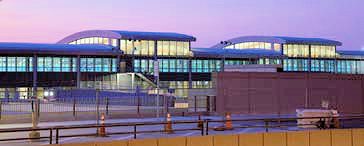
From a rolling roof design emulating the natural landscape of central North Carolina to carpet patterns of abstract DNA sequences representing the region’s high-tech industries, Raleigh-Durham International Airport (RDU) has captured the essence of the local area in its newly debuted Terminal 2.
|
Raleigh-Durham International |
With a spacious feel, plenty of natural daylight and easy navigation, Terminal 2 is three times larger than the original Terminal C. As such, it’s expected to ease the current congestion in the confined Terminal 1.
Facts and Figures Project: Location: Size: Cost: Lead Architect: Associate Architects: Project Management: General Contractor: Local Angle:
Same Site, Different Facility
RDU director of Major Capital Improvements Dave Powell says Terminal 2 is a welcome replacement to Terminal C, a building that was developed and put into service in 1987 for American Airlines as a 25-gate hub terminal. American de-hubbed at RDU shortly thereafter in the early 1990s, minimizing its presence to a handful of gates.
Terminal C managed to retain its hub status when Midway Airlines relocated to RDU from Chicago, using 20 of the terminal’s 25 gates. This arrangement continued until the tragic events of 9/11.
Midway never restarted operations after airspace was shut down, Powell recalls. The few remaining American gates were operating in a ghost town environment.
“The only airline operating over there was American at that point, so we had a building that was very much underutilized,” Powell comments, noting the original building had been constructed to accommodate 85% of the transfer traffic and 15% of local traffic. “We started to look at that building to see how we could better utilize it and had intended to renovate it. But the more we looked at it, we found it would be really difficult to turn this small airline hub terminal into an origin and destination, post-9/11 terminal.

“It made more sense to tear it down and build a new terminal on the same site. Our board agreed with that approach.”

After the Airport Authority purchased American Airlines’ lease for Terminal C in 2002, it began plans to construct a new terminal with a larger footprint in the same location. Part of the existing Terminal C was torn down to begin construction.
The existing part of Terminal C accommodated American, United and Air Canada throughout the first phase of construction on Terminal 2. Since the first phase of Terminal 2 opened in late October, those carriers have moved into the new building from the old building. This paves the way for RDU to tear down the rest of Terminal C and continue the second phase of construction in Terminal 2. In addition to the movements from Terminal C, Delta will move from Terminal A to the new terminal.
Work Continues
As operations flip from the old buildings to the new building, RDU maintained that a mini-celebration was in order.
“We are having a mini-celebration because we’re only halfway done,” Powell says, noting that 19 gates are opening in the first phase.
The second phase, scheduled to open in early 2011, will see the total grow to 36 gates. The first part of the building opening represents 60% percent of the total; the remaining 40% of the square footage opens in phase 2.
According to Powell, RDU’s new Terminal 2 is far from a hub facility.
“When the new building is completely finished, it will be a 920,000-square-foot common-use facility from top to bottom, inside out,” he says. “All of the ticket counters are assignable by airline, as are all of the hold rooms and bag belts. No one is locked in anywhere.”
Common-use components will be aided with dynamic displays by IBM and Ultra Electronics Airport Systems. Dynamic displays are also a vital component of Interspace Airport Advertising’s 10 1/2-year contract extension with RDU.
“We are taking the older, traditional-style displays and transitioning them into an all-digital program,” says Interspace Airport Advertising marketing consultant Jim Hughes. “We do have some stretch fabric displays and a couple of floor displays, but 90%, is digital.”
RDU marketing communications specialist Andrew Sawyer says travelers passing through Terminal 2 are going to have a much different experience than they had in RDU’s previous facilities.
“The new building is a column-free building with a very large and spacious concourse,” Sawyer describes. “There are more shops and amenities such as power for laptops, and all of the advanced security equipment is behind the scenes. So we’re going from a pre-9/11 hub terminal that has been adopted to work the best it can, to a modern terminal building.”
When fully complete, Sawyer says Terminal 2 will be “a great improvement” over the existing facilities.



